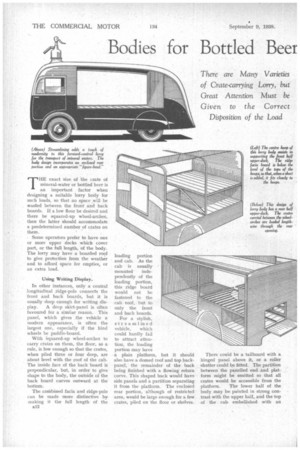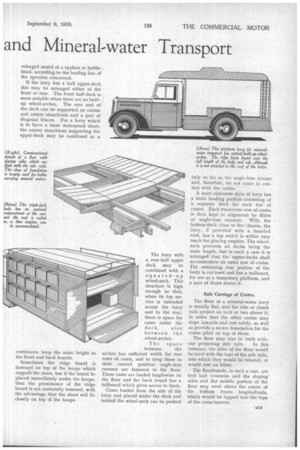Bodies for Bottled Beer and Mineral-water Transport
Page 46

Page 47

If you've noticed an error in this article please click here to report it so we can fix it.
THE exact size of the crate of mineral-water or bottled beer is an important factor when designing a suitable lorry body for such loads, so that no space will be wasted between the front and back boards. If a low floor be desired and there be squared-up wheel-arches, then the latter should accommodate a predetermined number of crates on them.
Some operators prefer to have one or more upper decks which cover part, or the full length, of the body. The lorry may have a boarded roof to give protection from the weather and to afford space for empties, or an extra load.
Using Writing Display.
In other instances, only a central longitudinal ridge-pole connects the front and back boards, but it is usually deep enough for writing dis play. A deep skirt-panel is often favoured for a similar reason. This panel, which gives the vehicle a modern appearance, is often the largest one, especially if the hind wheels be paddle-boxed.
With "squared-up wheel-arches to carry crates on them, the floor, as a rule, is low enough so that the crates, when piled three or four deep, are about level with the roof of the cab. The inside face of the back board is perpendicular, but, in order to give shape to the body, the outside of the back board curves outward at the bottom.
The combined facia and ridge-pole can be made more distinctive by making it the full length of the al.2 loading portion and cab. As the cab is usually mounted independently of the loading portion, this ridge board would not be fastened to the cab roof, but to only the front and back boards.
For a stylish, streamlined vehicle, which could hardly fail to attract attention, the loading portion may have a plain platform, but it should also have a domed roof and top backpanel, the remainder of the back being finished with a flowing return curve. This shaped back would have side panels and a partition separating it from the platform. The encloSed rear portion, although of restricted area, would be large enough for a few crates, piled on the floor or shelves. There could be a tailboard with a hinged panel above it, or a roller shutter could be fitted. The partition between the panelled end and platform might be omitted so that all crates would be accessible from the platform. The lower half of the body may be painted in strong contrast with the upper half, and the top of the cab embellished with an enlarged model of a syphon or bottlehead, according to the leading line of the operator concerned.
If the lorry has a half upper-deck this may be arranged either at the front or rear. The front half-deck is more suitable when there are no builtup wheel-arches. The rear end of the deck can be supported on corner and centre stanchions and a pair of diagonal braces. For a lorry which is to have a loose waterproof sheet, the corner stanchions supporting the upper-deck may be combined as a continuous hoop the same height as the front and back boards.
Sometimes the ridge board is fastened on top of the hoops which support the sheet, but if the board be placed immediately under the hoops, then the prominence of the ridgeboard is not materially lessened, with the advantage that the sheet will lie closely on top of the hoops.
The lorry with a rear-half upper deck may be combined with a squared-up wheel-arch. This structure is high enough so that, when its top service is extended across the lorry and to the rear, there is space for cases under the deck, also between the wheel-arches. The space between the arches has sufficient width for two rows of cases, and to keep these in their correct position angle-iron runners are fastened to the floor. These cases are loaded lengthwise on the floor and the back board has a tailboard which gives access to them, Cases loaded from the side of the lorry and placed under the deck and behind the wheel-arch can be pushed only so far as the angle-iron runner and, therefore, do not come in contact with the crates: A more elaborate style of lorry has a main loading portion consisting of a separate deck for each tier of crates. Each transverse row of crates is then kept in alignment by fillets or angle-iron runners.. With the bottom-deck close to the chassis, the lorry, if provided with a boarded roof, has a top which is within easy reach for placing empties. The wheelarch prevents all decks being the same length, but in such a case it is arranged that the upper-decks shall accommodate an extra row of crates. The remaining rear portion of the body is enclosed and has a tailboard, for use as a temporary platform, and a pair of doors above it.
Safe Carriage of Crates.
The floor of a mineral-water lorry is usually flat, and the side or chock rails project an inch or two above it, in order that the other crates may slope inwards and rest safely, as well as provide a secure foundation for the crates piled on top of them.
The floor may also be built with
out projecting side rails. In this instance, the sides of the floor would be level with the tops of the side rails, into which they would be rebated, or would rest on fillets.
The floorboards, in such a case, are best laid. crosswise and the sloping' sides and flat middle portion of the floor may meet above the centre of the bottom frame longitudinals, which would be lapped into the tops of the cross-bearers.




















































































